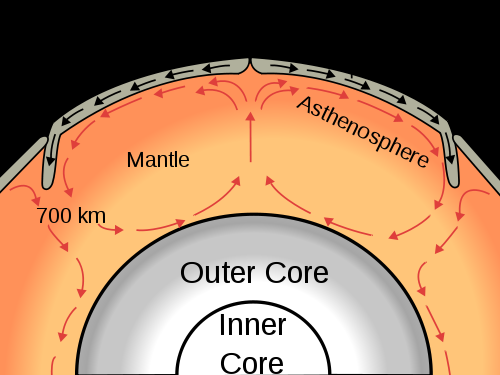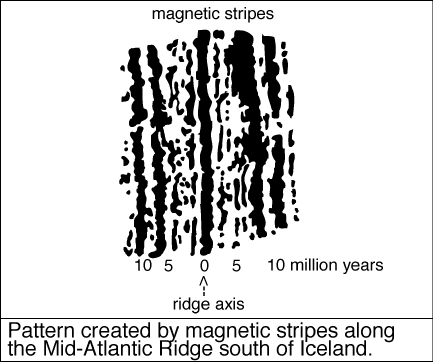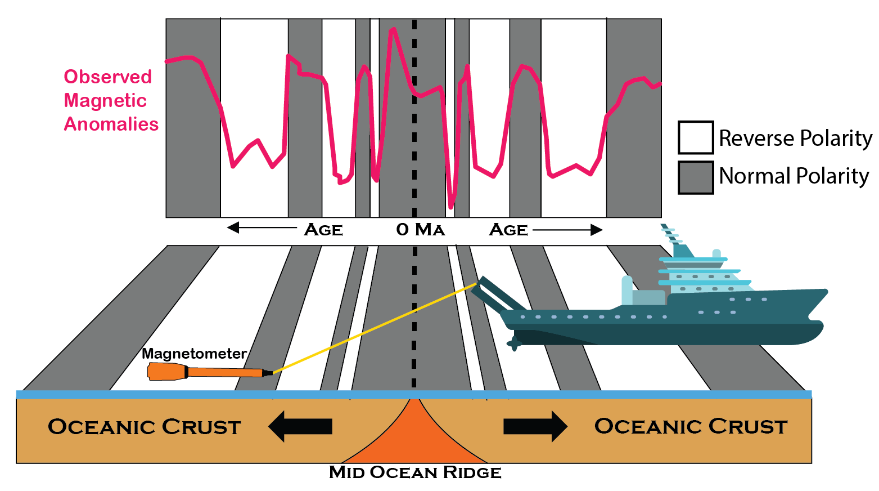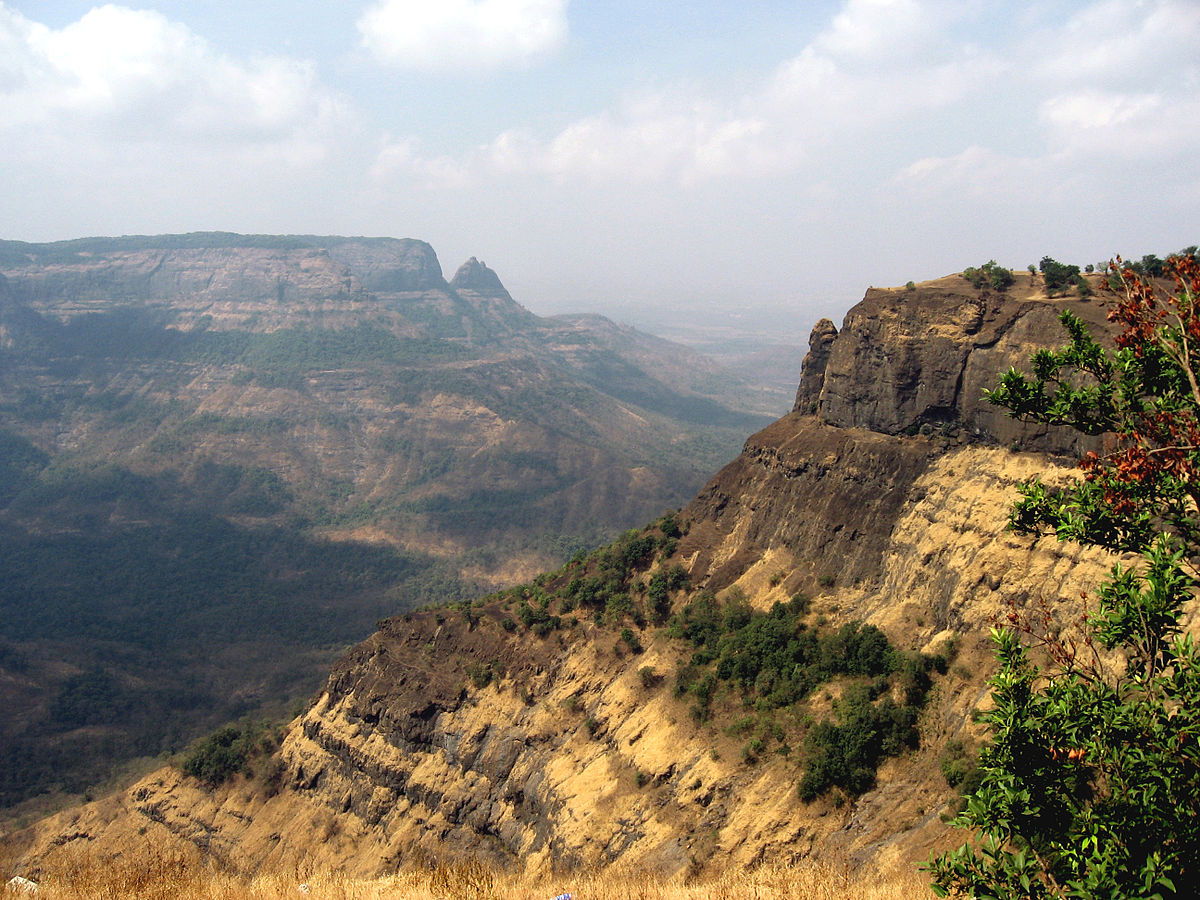Appendix: The mixed blessing of plate tectonics
Put in basic terms, plate tectonics is the slow convective churning of rock that moves the planet’s surface plates around. It involves parts of some plates being taken beneath others (subduction), with new material reaching the surface as spreading, particularly on oceanic plates, plus volcanic eruptions and mountain-building by uplift where plates collide.
The most dramatic playing-out of tectonics is surely the spreading of the Atlantic Ocean floor that separated Europe and Africa from the America, leaving cookie-cutter edges where the continents were formerly joined. Also dramatic is the Ring of Fire of the North Pacific Ocean where several plates abut each other, jostling each other and creating great numbers of earthquakes. The slow but enormously energetic collision of India with South Asia to build the Himalayas is in the running, too. There are many other features of tectonics to cite. They include evidence of repeated joining and breakup of continents, such that flora and fauna of Australia are strongly related from earlier joint evolution with flora and fauna of Africa. There is the vast changes in latitude, with dinosaur fossils being found in Antarctica when it was reliably inferred to have been only about 8° from the South Pole (but the Earth was quite hot then). The very existence of the continents as dry land above the oceans is a result of plate tectonics scraping up lighter crust to pile it up in mounds we call continents.
How it works, physically: rock appears solid enough but deforms under great force, as a hyperviscous liquid. This can be demonstrated in labs with high-pressure equipment. It is also evident in the distortion of the Earth from a nearly perfect spherical shape to a prolate spheroidal shape, bulged out at the equator where the centrifugal force thrusting out rock is highest. I have a posting that discusses this bulging by treating the Earth as a fluid. In the post and in another post on how science infers the pressure of rock with depth to the core I discuss the evidence for the structure of the Earth as revealed by the ways that earthquake waves propagate through the Earth.
As in a boiling ordinary liquid heated from below, the mantle and outer core move in vast vertical eddies. Hotter rock is less dense than cooler rock, so it rises hydrostatically. As it cools near the surface it sinks back. The flows can entrain the tectonic plates of the crust, leading to subduction and spreading.

All schoolchildren note the fitting together of continents (at least, they did in the US until schools stopped teaching geography in response to ill-planned educational “reforms”). German polar explorer, geophysicist, and meteorologists Alfred Wegener took it further. He cited evidence of many continental junctures and of the similarity of fossils on continents now far apart. He argued against land bridges being the joining for organisms on different continents – they violate physical principles of how rocks “float” on each other, or isostasy. He recognized the Mid-Atlantic Ridge in the ocean as a spreading point. That massive ridge was discovered in 1872 during the voyage of the HMS Challenger to plan the laying of the first transatlantic telegraph cable!
The treatment of Wegener’s hypothesis is often cited as the mere stubbornness of scientists but it really shows in the main the correct operation of science. Extraordinary claims require extraordinary evidence. A key empirical finding supporting the tectonic hypothesis was the pattern of reversals of direction in the magnetization of rocks along the spreading direction.

serc.carleton.edu
Mars for Earthlings
earthref.org

It arises from periodic reversals of the magnetic field of the Earth. That itself is a wild idea but supported in part by the identity of reversals of magnetization on both sides of the ridge. Much more evidence accumulated, including the deformability of rock under shear stress and a vast array of fossil congruences across land masses. Science can now reconstruct long histories of continents joining and separating. Great numbers of presentations in stills and videos are available- e.g., https://www.youtube.com/watch?v=IlnwyAbczog and https://www.youtube.com/watch?v=q-ng6YpxHxU and https://www.youtube.com/watch?v=KfYn9KVya-Q.
Plate tectonics is powered by a continuous heat source. Really, it’s sources. One big source is the heat of gravitational coalescence of the Earth from the dust of the planetary nebula. Colliding makes for heating, much as hammering metal does, but at great magnitude. The core is the hottest, inferred from a wide range of evidence as being above 6000K, with the heat slowly rising to the surface by conduction and, more so, by convection. To reprise more from the main text here: There is also the radioactive decay of uranium, potassium, and thorium; recall that potassium is mildly radioactive, with a half-life of 1.25 billion years. Another source is the solidification of the core, releasing the heat of fusion. Yet one more is the continued migration of heavy elements deeper into the interior, with the loss of gravitational potential being converted into heat. Ask any miner or mining engineer – it’s hotter every step down toward the core, about 1°C per 40 meters. Even at a milder site, 3.9 km (2.4 mi) down in Earth’s deepest mine, the TauTona gold mine, the rock face is at 60oC or 140oF (miners only stay alive with air conditioning!). At the surface where rock is rigid, its thermal conductivity is low. In the convecting mantle the net conductivity is more than 25 times greater; the temperature gradient is only 1°C per km.
This takes us to a who, what, and where of the classical charge to a newspaperperson. The when issue has been researched as well – When did tectonics start on Earth, and did it ever operate on Mars and Venus, our rocky planet neighbors. The latest evidence is that plate tectonic movements started when the Earth was about 1.6 billion years old, a bit more than 1/3 of its current age. Mars shows no evidence of plate tectonics other than perhaps some small marsquakes detected recently by the Insight Lander. Still, no vast plate fissures show on the surface. Mars may just be too small, not hot enough. Venus is nearly Earth-sized. Its surface shows relatively low mountains, evidence of tectonics but more localized, not global. Its crustal rocks weak are weak and now very hot (last 700 million years), not lending them to rigid plate motion. Back to Earth: its water helps to lubricate convection of the mantle and plate subduction. Mars never had much water, losing it to gravitational escape of hydrogen atoms.
So, Earth lucked out, in part, in having plate tectonics. We did get continents for land organisms to stand on, as it were. We got surface renewal of chemical elements. That includes massive recycling of carbon for our greenhouse effect, as noted in the main text. We also got huge swings in surface temperature from changes in the greenhouse gas content of the atmosphere plus realignments of continents that changed the circulation of wind and ocean. From the time of emergence of multicellular life we got five mass extinctions or more, depending on how we lump or split events. Most appear due to plate tectonics generating massive volcanism for high CO2, huge rates of rock weathering to make CO2 plummet, or the aforementioned continental alignments. Even the extinction at the boundary between the Cretaceous Period and our Tertiary Period 65 million years ago may have a big tectonic contribution. There is demonstrably the impact of a great asteroid that shook the Earth, throwing up vast clouds of dust and more to alter temperatures and the productivity of plants, on which all animal life relies. However, the asteroid may have multiplied its effect, triggering extension of eruption of the Deccan Traps.

The Traps blasted a lot of CO2 into the air and then helped swing the concentration lower violently from weathering of the Traps that took up CO2. Earth is not intrinsically life-friendly, even while it has good average conditions of insolation, mineral availability, etc. As my wife, Dr. Lou Ellen Kay, says, if Earth with all its plusses still nearly kills off its life, think how much that reduces the chances of life on another planet where not even all of Earth’s plusses are present.